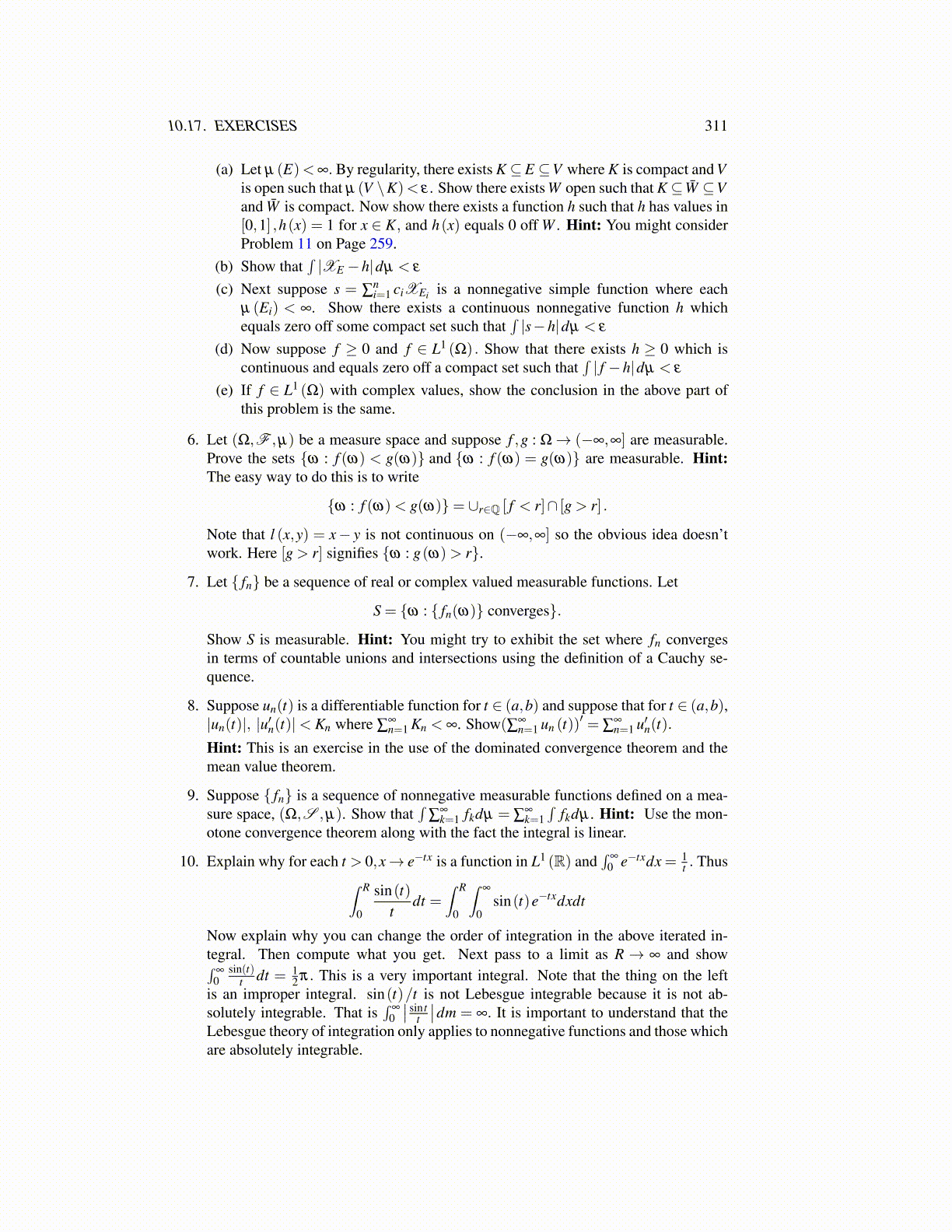
10.17. EXERCISES 311
(a) Let µ (E)<∞. By regularity, there exists K ⊆E ⊆V where K is compact and Vis open such that µ (V \K)< ε . Show there exists W open such that K ⊆ W̄ ⊆Vand W̄ is compact. Now show there exists a function h such that h has values in[0,1] ,h(x) = 1 for x ∈ K, and h(x) equals 0 off W . Hint: You might considerProblem 11 on Page 259.
(b) Show that∫|XE −h|dµ < ε
(c) Next suppose s = ∑ni=1 ciXEi is a nonnegative simple function where each
µ (Ei) < ∞. Show there exists a continuous nonnegative function h whichequals zero off some compact set such that
∫|s−h|dµ < ε
(d) Now suppose f ≥ 0 and f ∈ L1 (Ω) . Show that there exists h ≥ 0 which iscontinuous and equals zero off a compact set such that
∫| f −h|dµ < ε
(e) If f ∈ L1 (Ω) with complex values, show the conclusion in the above part ofthis problem is the same.
6. Let (Ω,F ,µ) be a measure space and suppose f ,g : Ω→ (−∞,∞] are measurable.Prove the sets {ω : f (ω) < g(ω)} and {ω : f (ω) = g(ω)} are measurable. Hint:The easy way to do this is to write
{ω : f (ω)< g(ω)}= ∪r∈Q [ f < r]∩ [g > r] .
Note that l (x,y) = x− y is not continuous on (−∞,∞] so the obvious idea doesn’twork. Here [g > r] signifies {ω : g(ω)> r}.
7. Let { fn} be a sequence of real or complex valued measurable functions. Let
S = {ω : { fn(ω)} converges}.
Show S is measurable. Hint: You might try to exhibit the set where fn convergesin terms of countable unions and intersections using the definition of a Cauchy se-quence.
8. Suppose un(t) is a differentiable function for t ∈ (a,b) and suppose that for t ∈ (a,b),|un(t)|, |u′n(t)|< Kn where ∑
∞n=1 Kn < ∞. Show(∑∞
n=1 un (t))′ = ∑
∞n=1 u′n(t).
Hint: This is an exercise in the use of the dominated convergence theorem and themean value theorem.
9. Suppose { fn} is a sequence of nonnegative measurable functions defined on a mea-sure space, (Ω,S ,µ). Show that
∫∑
∞k=1 fkdµ = ∑
∞k=1
∫fkdµ . Hint: Use the mon-
otone convergence theorem along with the fact the integral is linear.
10. Explain why for each t > 0,x→ e−tx is a function in L1 (R) and∫
∞
0 e−txdx = 1t . Thus∫ R
0
sin(t)t
dt =∫ R
0
∫∞
0sin(t)e−txdxdt
Now explain why you can change the order of integration in the above iterated in-tegral. Then compute what you get. Next pass to a limit as R → ∞ and show∫
∞
0sin(t)
t dt = 12 π. This is a very important integral. Note that the thing on the left
is an improper integral. sin(t)/t is not Lebesgue integrable because it is not ab-solutely integrable. That is
∫∞
0
∣∣ sin tt
∣∣dm = ∞. It is important to understand that theLebesgue theory of integration only applies to nonnegative functions and those whichare absolutely integrable.